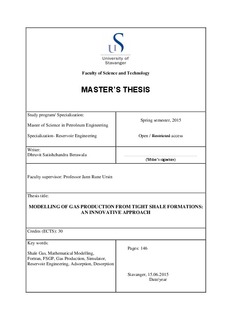| dc.contributor.author | Berawala, Dhruvit Satishchandra | |
| dc.date.accessioned | 2015-09-23T06:39:57Z | |
| dc.date.available | 2015-09-23T06:39:57Z | |
| dc.date.issued | 2015-06-15 | |
| dc.identifier.uri | http://hdl.handle.net/11250/301296 | |
| dc.description | Master's thesis in Petroleum engineering | nb_NO |
| dc.description.abstract | Shale gas is one of the most rapidly growing forms of natural gas. Unconventional natural gas deposits are difficult to characterize overall, but in general are often lower in resource concentration and more dispersed over large areas. Moreover, gas is densely packed into the matrix which account for large volume of gas reserves. Gas production from this tight shale deposits are made possible by extensive and deep well fracturing which contacts large fractions of the formation. Production of gas takes place by diffusion of adhered gas in the matrix and by Darcy type flow in the fractures.
This thesis aims at detailed modeling of gas desorption, diffusion and flow in combination with statistical representation of the two processes. The representation of the model involves a cube as a porous media and a sphere inside it where gas is adsorbed. Gas is considered to be densely packed into the sphere which desorbs and then diffuses to the pore space and fractures in the cube on variation in concentration of gas and pressure decline. Many of these representative but general cells of the reservoir are put together and linked to a well or well fracture. The thesis quantitatively describes these processes as well as clarifies the geological conditions under which a successful shale gas production could be expected.
A mathematical model has been derived which is then compiled on FORTRAN to develop a simulator for the production of shale gas by considering sphere as a source term in each of the grid block. The obtained production plot explains the unique characteristics of gas production from tight shale formations.
This thesis also includes an analytical fracture model for a linear inflow and linear flow in the vertical fracture. The analytical model has been used to compare the pressure in fracture with that of numerical solution. The obtained results highlight the stability and applicability of the numerical model. | nb_NO |
| dc.language.iso | eng | nb_NO |
| dc.publisher | University of Stavanger, Norway | nb_NO |
| dc.relation.ispartofseries | Masteroppgave/UIS-TN-IPT/2015; | |
| dc.subject | petroleumsteknologi | nb_NO |
| dc.subject | reservoarteknologi | nb_NO |
| dc.subject | shale gas | nb_NO |
| dc.subject | mathematical modelling | nb_NO |
| dc.subject | fortran | nb_NO |
| dc.subject | fsgp | nb_NO |
| dc.subject | gas production | nb_NO |
| dc.subject | simulator | nb_NO |
| dc.subject | adsorption | nb_NO |
| dc.subject | diffusion | nb_NO |
| dc.subject | desorption | nb_NO |
| dc.title | Modelling of gas production from tight shale formations: An innovative approach | nb_NO |
| dc.type | Master thesis | nb_NO |
